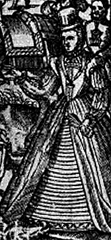
The Queen Out Hunting, c. 1575
Engraving in The Noble Arte of Venerie or Hunting
British Museum
Queen Elizabeth, like her father before here, was notorious for her ostentation in dress. This picture, however, shows the Queen in a more typical noblewoman's dress of 1575, less fabulous than the garb she wears in her Pelican Portrait or Phoenix Portrait.
She is wearing a high-necked partlet gathered to a small ruff. Her bodice, cut square at the neck, is exceedingly stiff and flat; the bands of trim down the front indicate that it could open at the front with hooks and eyes. Alternately, the trim could merely be decoration. The front point of the bodice ends only slightly below the waist, and there is a general dearth of the elaborate embroidery, trim, pearls, and jewelling which appear on Elizabeth's most famous gowns. Hunting required a more "practical" gown, it seems.
Relatively modest sleeve-puffs hide the laces which tie the striped sleeves of her gown to the bodice itself. The sleeves are slightly puffed, and are slit down the front and tied closed with ribbons to show the chemise underneath. The size of the oversleeves are similar to that of the sleeves worn by An Unknown Lady in 1569. The breadth and width of the fashionable sleeve would increase throughout the Queen's reign.
The skirt is cartridge pleated, either to a skirt band or to the bodice itself. Cartridge pleating was a method of gathering bulky material which elimanated the waistband-bulk of knife or box pleats; the material was folded over at the top, and three lines of stitching 1/4 to 1/2 inch apart, with all stitches the same size (going into and coming out of the fabric at the same places) for all three rows, were sewn along the top edge. When gathered , the fabric accordioned togther in evenly-spaced gathers. The gathered edge of the fabric itself was whipstitched at each gather to the bodice or waistband. Cartridge pleating makes a skirt spring out horizontally more than normal pleating. It's a complex concept if you've never done it; perhaps I'll add a page on the Process to the Elizabethan Costuming Homepage.
Underneath the pleated overskirt is either a striped underskirt or a triangular spanish farthingale with boning in the dark casings. The bottom edge is "guarded", or edged, with a line of embroidery or trim. Usually, when hunting or riding, women of means would wear a "safeguard" over their skirts--another skirt meant to protect them from the mud, rain and elements. Although she doesn't seem to be wearing one here, Elizabeth's wardrobe lists a number of safeguards among her clothing.
In this portrait, the Queen is wearing a tall hat--the only one of her portraits in which she does so. Such hats became popular for both men and women during the late 16th century. Some were covered in leather, some in cloth, but all were pleated to a brim.
Next: The Queen of International Fashion